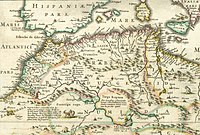Zayyanid Kingdom of Tlemcen مملكة تلمسان (Arabic) | |||||||||||||||||
|---|---|---|---|---|---|---|---|---|---|---|---|---|---|---|---|---|---|
| 1235–1556 | |||||||||||||||||
|
One of the flags attributed to Zayyanid Tlemcen[a] | |||||||||||||||||
![The kingdom of Tlemcen at the beginning of the 14th century.[2]](http://upload.wikimedia.org/wikipedia/commons/thumb/6/60/Zayyanid_Kingdom_at_the_beginning_of_the_14th_century.png/250px-Zayyanid_Kingdom_at_the_beginning_of_the_14th_century.png) The kingdom of Tlemcen at the beginning of the 14th century.[2] | |||||||||||||||||
| Capital | Tlemcen | ||||||||||||||||
| Common languages | Berber, Maghrebi Arabic | ||||||||||||||||
| Religion | Sunni Islam | ||||||||||||||||
| Government | Monarchy | ||||||||||||||||
| Sultan | |||||||||||||||||
• 1236–1283 | Abu Yahya I bin Zayyan | ||||||||||||||||
• 1318-1337 | Abu Tashufin I | ||||||||||||||||
• 1359-1389 | Abu Hammu II | ||||||||||||||||
• 1468–1504 | Abu Abdallah IV | ||||||||||||||||
• 1550–1556 | Al Hassan ben Abu Muh | ||||||||||||||||
| History | |||||||||||||||||
| 1235 | |||||||||||||||||
| 1248 | |||||||||||||||||
| 1264 | |||||||||||||||||
| 1299-1307 | |||||||||||||||||
| 1329 | |||||||||||||||||
| 1337-1348 | |||||||||||||||||
| 1352-1359 | |||||||||||||||||
| 1411 | |||||||||||||||||
• Conflicts with the Spaniards | 1504–1512 | ||||||||||||||||
| 1556 | |||||||||||||||||
| Currency | Dinar | ||||||||||||||||
| |||||||||||||||||
| History of Algeria |
|---|
 |
The Kingdom of Tlemcen or Zayyanid Kingdom of Tlemcen (Arabic: الزيانيون) was a kingdom ruled by the Berber Zayyanid dynasty[3][4] in what is now the northwest of Algeria. Its territory stretched from Tlemcen to the Chelif bend and Algiers, and at its zenith reached Sijilmasa and the Moulouya River in the west, Tuat to the south and the Soummam in the east.[5][6][7]
The Tlemcen Kingdom was established after the demise of the Almohad Caliphate in 1236, and later fell under Ottoman rule in 1554. The capital of the kingdom was Tlemcen, which lay on the primary east–west route between Morocco and Ifriqiya. The kingdom was situated between the realm of the Marinids to the west, centred on Fez, and the Hafsids to the east, centred on Tunis.
Tlemcen was a hub for the north–south trade route from Oran on the Mediterranean coast to the Western Sudan. As a prosperous trading centre, it attracted its more powerful neighbours. At different times the kingdom was invaded and occupied by the Marinids from the west,[8] by the Hafsids from the east, and by Aragonese from the north. At other times, they were able to take advantage of turmoil among their neighbours: during the reign of Abu Tashfin I (r. 1318–1337) the Zayyanids occupied Tunis and in 1423, under the reign of Abu Malek, they briefly captured Fez.[9][10]: 287 In the south the Zayyanid realm included the Tuat, Tamentit, and Draa regions which was governed by Abdallah Ibn Moslem ez Zerdali, a sheikh of the Zayyanids.[11][12][5]
- ^ de Vries, Hubert (2015) [2011]. "AL DJAZAIR - Algeria". Heraldica civica et militara. Archived from the original on 2023-04-03. Retrieved 2023-10-21.
- ^ Baydal Sala, Vicent (19 Nov 2017). "Religious motivations or feudal expansionism? The Crusade of James II of Aragon against Nasrid Almeria in 1309-10". Complutense University of Madrid. Archived from the original on 2 November 2021. Retrieved 7 July 2020.
- ^ "Abd al-Wadid Dynasty | Berber dynasty". Archived from the original on 2016-08-06. Retrieved 2016-07-22.
- ^ Appiah, Kwame Anthony; Gates, Henry Louis, eds. (2010). Encyclopedia of Africa. Oxford University Press. p. 475. ISBN 9780195337709. Archived from the original on 2023-01-11. Retrieved 2016-07-22.
- ^ a b الدولة الزيانية في عهد يغمراسن: دراسة تاريخية وحضارية 633 هـ - 681 هـ / 1235 م - 1282 مخالد بلع Archived 2023-06-07 at the Wayback Machine ربي Al Manhal
- ^ "The Abdelwadids (1236–1554)". Qantara. Archived from the original on 2013-11-12. Retrieved 2013-05-15.
- ^ L'Algérie au passé lointain – De Carthage à la Régence d'Alger, p175
- ^ Despois et al. 1986, p. 367.
- ^ Tarabulsi 2006, p. 84.
- ^ Cite error: The named reference
:3was invoked but never defined (see the help page). - ^ Ksour et saints du Gourara: dans la tradition orale, l'hagiographie et les chroniques locales Archived 2023-06-07 at the Wayback Machine. Rachid Bellil. C.N.R.P.A.H.
- ^ Histoire es berbères, 4 Archived 2023-06-07 at the Wayback Machine: et des dynasties musulmanes de l'afrique septentrionale. Abd al-Rahman b. Muhammad Ibn Jaldun. Imprimerie du Gouvernement.
Cite error: There are <ref group=lower-alpha> tags or {{efn}} templates on this page, but the references will not show without a {{reflist|group=lower-alpha}} template or {{notelist}} template (see the help page).
